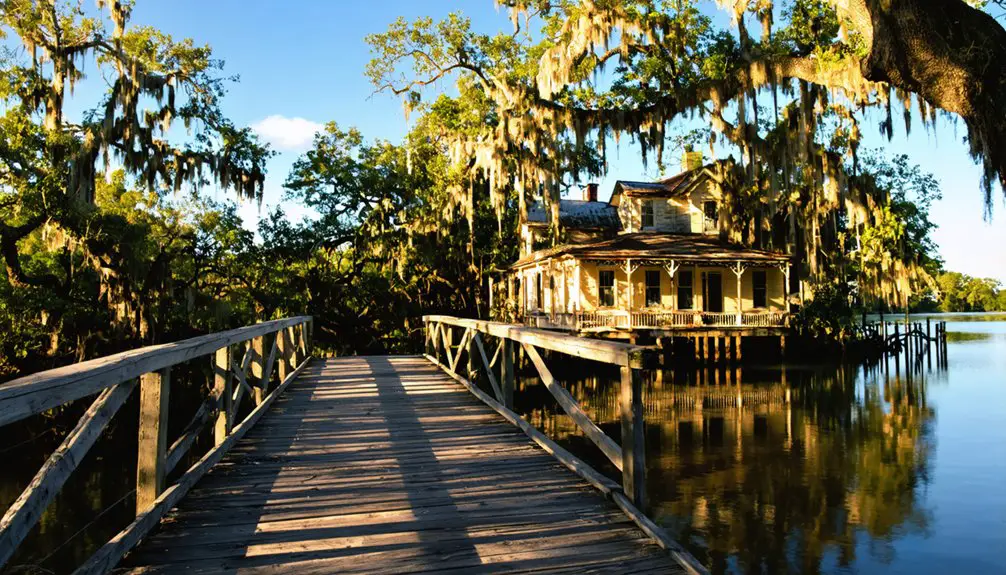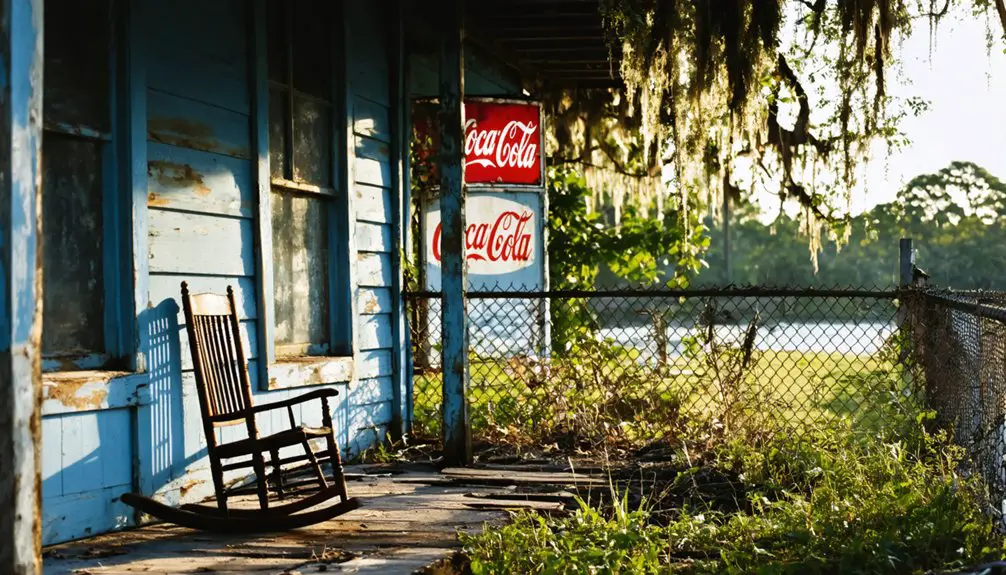You’ll find Fort Denaud along Florida’s Caloosahatchee River, 27 miles east of Fort Myers. Originally established as a military outpost in 1838, it evolved into an agricultural settlement after the Seminole Wars ended in 1858. Today, this inhabited ghost town features scattered historic structures, including the 1963 Fort Denaud Swing Bridge and pioneer cemetery. While citrus groves now dominate the landscape, remnants of its military and farming past await your discovery.
Key Takeaways
- Fort Denaud transitioned from a military fort to an agricultural community in 1858, but now exists as a sparsely populated ghost town.
- The area retains active citrus farming operations and modern homes amid the historic remnants of the original settlement.
- Few original structures survive, though the 1963 Fort Denaud Swing Bridge and Fort Denaud Cemetery remain prominent landmarks.
- Historic markers and weathered farmhouses from the late 1800s provide evidence of the area’s military and agricultural past.
- The community maintains its rural character along the Caloosahatchee River, blending inhabited areas with ghost town elements.
Military Origins and Strategic Importance
During the Second Seminole War in 1838, Captain B.L.E. Bonneville and his 7th Infantry troops established Fort Denaud on Pierre Denaud’s land along the Caloosahatchee River, 27 miles east of Fort Myers.
You’ll find this strategic outpost served as an essential military logistics hub, connecting operations from Tampa to Florida’s east coast.
Initially consisting of tents and a wooden storehouse, the fort’s supply chain capabilities proved significant for troops traversing the challenging Florida terrain.
When reactivated in 1855 during the Third Seminole War, Major William Hays expanded the fort with permanent structures including quarters, a hospital, and stables.
A devastating fire destroyed the fort in June 1856, forcing its relocation to the north bank of the river.
The fort’s position controlled a critical river crossing and enabled U.S. forces to launch patrols into Seminole territory while maintaining important supply lines between coastal and inland operations.
The site was permanently abandoned in May 1858, with the fort’s name later adopted by the surrounding settlement.
The Rise and Fall of Fort Structures
While Fort Denaud began modestly with tents and a wooden storehouse in 1837, its structures evolved to meet growing military demands. By 1855, you’d have found company quarters, a hospital, guardhouse, sutler’s store, and stables added to the original fort construction. Captain Bonneville established the initial fort layout during his command of the 7th U.S. Infantry.
From simple beginnings with tents and a storehouse, Fort Denaud expanded to include quarters, medical facilities, and essential military buildings.
The military architecture remained primarily temporary, using wood and fabric rather than the more durable coquina stone seen in other Florida forts. Today, old chimneys remain as silent witnesses to these former structures.
The fort’s location on the Caloosahatchee River proved both advantageous and challenging. Flooding forced its abandonment in 1855, and a devastating fire destroyed the structures in 1856.
The military responded by rebuilding Fort Denaud on the opposite riverbank in 1857, though this iteration also proved short-lived as the fort ceased military operations by the late 1850s.
Agricultural Legacy and Community Development
As Fort Denaud’s military presence waned in 1858, a thriving agricultural community took root along the fertile banks of the Caloosahatchee River. You’d have found extensive citrus groves and sugarcane fields dominating the landscape, with farmers leveraging the river’s proximity for crop transport. Located 27 miles east of Fort Myers, the area became an important agricultural hub.
The settlement’s crop diversification efforts included a sugar mill, though it ultimately closed in 1928. The fort’s original purpose as a supply depot supported early agricultural development in the region.
The community’s infrastructure expanded to include two schools, a hotel, and even a Florida Power & Light plant, showcasing the residents’ community resilience.
Despite these developments, Fort Denaud faced mounting challenges by the 1930s. Limited infrastructure, market fluctuations, and the sugar mill’s closure weakened the local economy.
Many buildings were relocated to LaBelle as residents departed, though the area’s agricultural legacy helped transform South Florida from wilderness to cultivated land.
Historical Significance in the Seminole Wars
The strategic establishment of Fort Denaud in 1838 marked a pivotal moment in the Second Seminole War, when Captain B.L.E. Bonneville built the post on Pierre Denaud’s land along the Caloosahatchee River.
You’ll find this military outpost served as a critical supply hub between Tampa and Florida’s east coast, supporting U.S. troops engaged in challenging swamp warfare. The indigenous fighters employed guerrilla warfare tactics that made conventional military operations extremely difficult.
While initially consisting of tents and a storehouse, the fort expanded considerably during the Third Seminole War in 1855.
Starting as a simple tent encampment and storehouse, Fort Denaud grew significantly as military operations intensified during the Third Seminole War.
Under Brevet Major William Hays’ command, it grew to include a hospital, guardhouse, and stables. The fort supported a garrison of approximately 150 men during its peak operations.
The fort’s military tactics focused on controlling river crossings and supporting campaigns against indigenous resistance.
You can trace the intense struggles through events like the 1856 ambush, where Seminole warriors attacked six U.S. cavalry soldiers, leaving just one survivor.
Present-Day Ghost Town Experience
When you visit Fort Denaud today, you’ll find a quiet ghost town marked by a few surviving historic structures, including an old fireplace and one or two original buildings near the Caloosahatchee River.
The area once thrived as a farming community focused on citrus and sugarcane cultivation. The rural setting showcases Florida’s agricultural heritage with sprawling orange groves and citrus operations surrounding the historic site. Similar to Fort Dade, the area contains military burial grounds that serve as a reminder of the region’s historical significance.
You’ll notice how the 1963 Fort Denaud Bridge, a distinctive swing-style structure, connects the site’s past to present while providing access to the old Fort Denaud Cemetery on the north side of the river.
Exploring Abandoned Historic Structures
Modern visitors exploring Fort Denaud‘s ghost town remnants will find scattered historical structures spread across the rural landscape near the Caloosahatchee River.
While the original military fort no longer stands, you’ll discover several examples of abandoned architecture from the late 1800s that tell the story of this historic settlement.
- Weather-worn chimney remains stand as silent sentinels along the roadside, marking where pioneer farmhouses once thrived.
- The Fort Denaud Cemetery preserves the area’s heritage on the north bank of the river.
- Original town structures and abandoned houses dot the countryside, showcasing historic preservation efforts.
- A historic marker near the Fort Denaud Bridge indicates where the original blockhouse stood before fire claimed it in 1856.
Rural Agricultural Setting Today
Surrounded by vast citrus groves and working farms, present-day Fort Denaud maintains its rural character through active agricultural operations.
You’ll find yourself immersed in a landscape dominated by orange groves and citrus farming operations, where trucks regularly transport fresh produce along State Road 80 and Fort Denaud Road.
The iconic 1963 swing bridge serves as your gateway to this agricultural community, where modern homes blend seamlessly with the countryside setting.
As you explore the area, you’ll notice how the rural lifestyle prevails, with scattered residences nestled among expansive farmland.
While few historic structures remain, the Fort Denaud Cemetery and a commemorative marker along the Caloosahatchee River stand as quiet reminders of the town’s past amid the working agricultural landscape.
Modern Bridge Meets History
Standing as a tribute to both progress and preservation, the 1963 Fort Denaud swing bridge serves as your primary gateway into this historic ghost town‘s remains.
This 434-foot engineering marvel continues its original bridge design, pivoting to allow boat traffic along the Caloosahatchee River, just as it has for six decades. You’ll find yourself at one of only three remaining vehicle swing bridges in Southwest Florida, where historical preservation meets daily necessity.
- The bridge’s 8.9-foot clearance frames your view of the winding river below
- A historic marker on the south bank reveals the area’s military past
- The nearby Fort Denaud Cemetery stands sentinel on the north shore
- Rural landscapes stretch out on both sides, largely unchanged since the 1800s
Surviving Landmarks and Heritage Sites

A historic marker on the south side of Fort Denaud Bridge now indicates where Captain Bonneville’s blockhouse once stood in 1838.
You’ll find this heritage preservation site near a distinctive curve in the road by the Caloosahatchee River, offering you context about the fort’s role in the Seminole Wars.
While the original fort structures have vanished since its 1858 abandonment, you can still explore the Fort Denaud Cemetery on the north riverbank, where pioneer graves tell stories of early settlers.
Throughout the area, you’ll discover scattered remnants of late 1800s rural life, including weathered farmhouses and old chimney ruins.
These landmarks, along with community engagement through historical education at the marker site, keep Fort Denaud’s military and agricultural legacy alive for future generations.
Frequently Asked Questions
What Is the Current Population of Fort Denaud?
You’ll find Fort Denaud’s population trends show recent estimates between 1,396 and 1,652 residents in 2023, down from 2,049 in 2020, reflecting shifting community demographics in this Florida location.
Are There Any Annual Events or Festivals Celebrating Fort Denaud’s History?
You won’t find specific historical reenactments or cultural festivals celebrating Fort Denaud’s past. Instead, you’ll discover nearby regional celebrations like the Swamp Cabbage Festival and Sugar Festival in Hendry County.
Can Visitors Take Guided Tours of the Historical Site?
You won’t find organized guided tours at this location. While the site holds historical significance, it’s primarily inhabited private property, so you’ll need to explore the area’s history through nearby museums instead.
What Native American Artifacts Have Been Found in the Area?
You’ll discover an incredible treasure trove of ceremonial artifacts near the Caloosahatchee River, from ancient mammoth-tusk spear points to Seminole silver tablets and archaeological findings of pottery and wooden carvings.
How Accessible Is Fort Denaud by Public Transportation Today?
You won’t find any public transport options in Fort Denaud today. There’s no bus service, reliable taxis, or rideshare accessibility options, so you’ll need your own vehicle to get around.
References
- https://ghosttownadventures.wordpress.com/2017/08/09/fort-denaud/
- https://www.legendsofamerica.com/fort-denaud-florida/
- https://raddoc1947.com/2021/04/10/historical-marker-fort-denaud/
- https://www.youtube.com/watch?v=XHuD2bhtz48
- https://en.wikipedia.org/wiki/Fort_Denaud
- https://kids.kiddle.co/Fort_Denaud
- https://myfloridahistory.org/date-in-history/january-18-1856/six-soldiers-ambushed-approximately-20-seminole-indians
- https://fortwiki.com/Fort_Denaud
- https://www.battlefields.org/learn/articles/floridas-forts
- https://www.captivasanibel.com/news/2021/11/southwest-florida-home-to-historical-military-sites/



